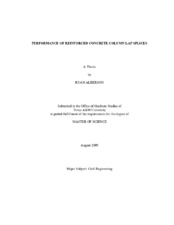| dc.description.abstract | Cantilevered reinforced concrete columns with a lap splice of the longitudinal
reinforcement near the base can induce high moment demands on the splice region when
lateral loads are present on the structure. Code design specifications typically require a
conservative splice length to account for these high moment demands and their
consequences of bond failure. The required splice length is calculated as a function of
required development length, which is a function of the bond between the reinforcement
and the surrounding concrete, and a factor depending on the section detailing. However,
the effects of concrete deterioration due to alkali silica reaction (ASR) and/or delayed
ettringite formation (DEF) may weaken the bond of the splice region enough to
overcome the conservative splice length, potentially resulting in brittle failure of the
column during lateral loading.
This thesis presents the following results obtained from an experimental and analytical
program.
* Fabrication of large-scale specimens of typical column splice regions with
concrete that is susceptible to ASR/DEF deterioration
* Measurement of the large-scale specimen deterioration due to ASR/DEF
accelerated deterioration
* Analytical model of the column splice region based on flexure theory as a
function of the development length of the reinforcement and a factor to account
for deterioration of the bond due to ASR/DEF
* Experimental behavior of two large-scale specimens that are not influenced by
premature concrete deterioration due to ASR/DEF (control specimens). This
experimental data is also used to calibrate the analytical model.
The conclusions of the research are that the analytical model correlates well with the
experimental behavior of the large-scale control specimens not influenced by ASR/DEF.
The lap splice region behaved as expected and an over-strength in the splice region is
evident. To account for ASR/DEF damage, the analytical model proposes a reduction
factor to decrease the bond strength of the splice region to predict ultimate performance
of the region with different levels of premature concrete deterioration. | en |


